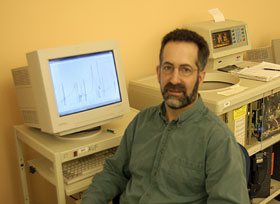|
This is an archived article.
For the latest news, go to the
Advance Homepage
For more archives, go to the Advance Archive/Search Page. | ||
|
UConn A Leader In Development For the past 30 years, UConn has led in the development of analytical ultracentrifugation (AUC), a powerful biophysical research tool that allows scientists to spin samples at extremely high speeds - 60,000 rpm, or about three times as fast as a regular centrifuge - and observe the movement of large molecules in real time.
The technique is particularly useful for biophysicists who study proteins, because it allows them to measure their size and shape, and to see how these large molecules interact. This is important information in basic research that could lead to such advances as the development of new drugs to treat HIV or finding ways to help the body fight viral infections. Those are both areas of study in the laboratory of James L. Cole, head of the University's National Analytical Ultracentrifugation Facility. The facility, established in 1988 with support from the National Science Foundation, is one of just a handful of centers around the country. Its investigators collaborate with others in academia and industry on a cost basis; they also conduct and collaborate with others on basic research. UConn is the only national facility to offer training in how to run AUC experiments. More than 400 researchers - including Cole, who came to UConn in 2001 from Merck Research Laboratories at West Point, Pa. - have trained here. The center, now located in the new Biology/ Physics Building, holds yearly workshops and conferences that teach scientists, technicians, and students from around the country to plan AUC experiments, use the latest analytical ultracentrifuges, and analyze data.
A History of Leadership Through their efforts, UConn became one of the first centers for analytical ultracentrifugation. The technique dates back to the 1920s, but it attracted more interest in the 1950s and 1960s, when commercial instrumentation became available. By the late 1970s, however, the technique began to fall out of favor with biophysicists, because the early model of the instrument had become obsolete and scientists became more interested in qualitative than in quantitative methods of analysis. Yphantis and his colleagues made a strong case to the manufacturer, Beckman-Coulter, to develop a new instrument, which it did in the early 1990s. The new equipment, along with new data analysis software that made AUC a far more powerful method for characterizing molecules, caused a dramatic resurgence of interest.
'Gold Standard' The $250,000 analytical ultracentrifuges at UConn are a little bigger than washing machines. A sample is placed in a cylindrical cell assembly about two inches long with a window at the top, then placed in a titanium rotor, which holds the cell within the centrifuge chamber. The air is pumped out by a vacuum pump and an optical system passes light through the sample as it spins around, so it can be observed in real time. The smallest sample placed in a cell would be about 20 microliters, an amount smaller than a drop of liquid. A protein to be analyzed is dissolved in liquid, usually an aqueous solution. Spinning is a nondestructive technique, so the protein can be recovered after the experiment. "AUC is considered the gold standard of measuring the molecular weight of proteins in solution," Cole says. An equilibrium experiment usually takes several days, and a sedimentation velocity experiment takes several hours. Analyzing the resulting data may take a researcher months, however.
Mechanisms of Proteins PKR is made by all vertebrates. Its synthesis is induced by interferon, which cells secrete in response to viral infection. Interferon primes neighboring cells to fight infection, and one way that they do this is by producing PKR. Cole uses AUC to understand the complicated bio-chemistry involved in the activation of PKR. The hepatitis C virus and several other viruses produce molecules that "turn off" PKR. If we could find a way to "turn on" PKR, Cole says, our ability to fight hepatitis C would be enhanced. He is also interested in the basic mechanisms of the proteins involved in the HIV virus - how proteins on the surface of the virus help HIV get into a host cell and infect it, and the mechanism of HIV integrase. HIV integrase is a protein produced by the virus that enables HIV genetic material to become incorporated into a healthy cell. His goal is to understand, and ultimately find ways to inhibit, the replication of HIV. Cole, an associate professor of molecular and cell biology, earned his Ph.D. in biophysical chemistry from the University of California, Berkeley, and was a postdoctoral fellow at Stanford. He began his career as an undergraduate majoring in biochemistry at Brown University, but later became more interested in the physics, chemistry, and mathematics underpinning the mechanisms of biological systems. UConn is one of the few institutions in the country that offers a biophysics degree for undergraduates, Cole says. Undergraduate biochemists and biophysicists work in his laboratory, along with three graduate students. The facility has applied for federal funding to develop a new generation of analysis software that will expand the utility of the centrifuges and allow researchers to tackle more complex problems. Cole also is looking for ways to use AUC to complement information that is emerging from the human genome project. |

